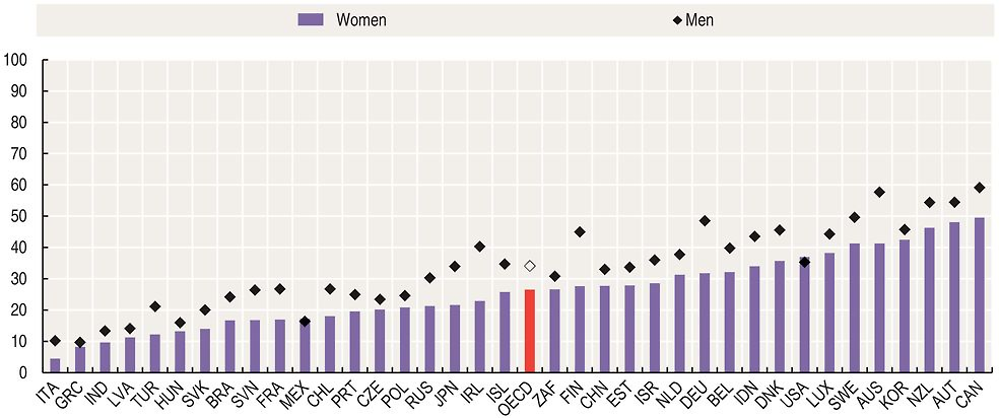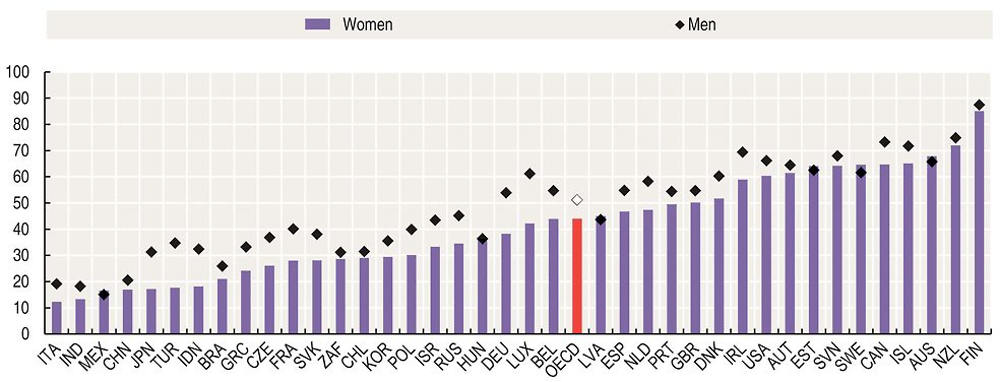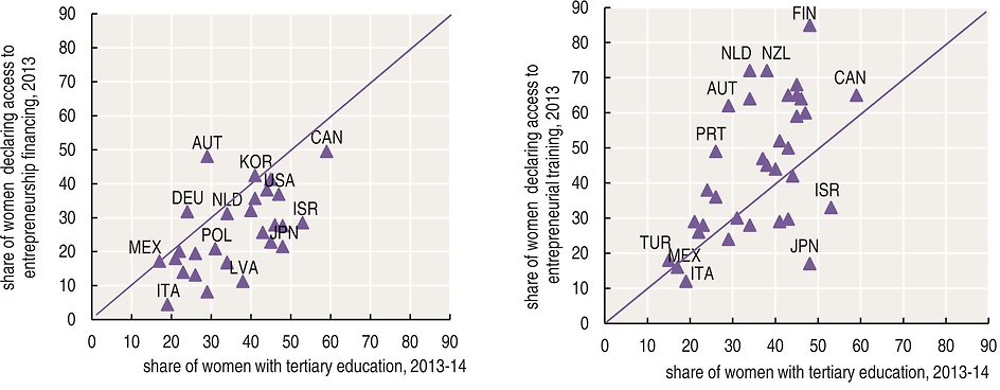Perception of entrepreneurial risk
Key facts
-
Most countries in the OECD area exhibit a gender gap with regard to access to entrepreneurship finance to create and grow a start-up; on average, only 27% of women compared to 34% of men declare that they would have access to money to set up a business.
-
Similar gender gaps exist with regard to access to training, although the OECD average of individuals who consider that they would have access is higher for both men (51%) and women (44%). There are, however, important differences across countries: in Finland, the share is above 80% for men and women, while in Italy and Mexico the share is below 20%.
-
Women’s perception on access to entrepreneurial finance and training to create and grow a business seem to be affected by a higher level of educational attainment by women in a country.
Access to entrepreneurship financing: The percentage of individuals, by gender, who answered “yes” to the question Do you have access to the money you would need if you wanted to start or grow a business? Financing could come from personal savings, loans, or any other source.
Access to entrepreneurial training: The percentage of individuals, by gender, who answered “yes” to the question Do you have access to training on how to start or grow a business, or not? Training can include any formal or informal means to learn about starting or growing a business.
Share of women with tertiary education is calculated as the share of women with tertiary education divided by the total population of women. Tertiary education corresponds to levels 5-8 of the International Standard Classification of Education (ISCED 2011).
Information on data for Israel: https://doi.org/10.1787/888932315602.
Relevance
An important determinant of entrepreneurship relates to the assessment of risk involved in creating a new business. This assessment is to a large extent determined by the risk of failure but also reflects other factors, such as social security safety nets, access to finance, access to child-care, and indeed potential rewards; which helps to explain the significant differences across countries on how entrepreneurial risk is perceived.
Comparability
Data are drawn from Gallup Worldwide Research, which surveys residents in more than 150 countries, using randomly selected, nationally representative samples. The sample typically consists of 1000 individuals, aged 15 and older, in each country. Telephone interviews and face-to-face interviews are used.
Samples cover the resident population in the entire country, including rural areas. Exceptions include areas where the safety of interviewing staff is threatened, scarcely populated islands in some countries, and areas that are particularly difficult to access. In order to ensure a nationally-representative sample for each country, data weighting is used and applied for calculations within a country.
Sources
Gallup World Poll, www.gallup.com/services/170945/world-poll.aspx.
OECD Education at a Glance Indicators.
Further readings
OECD (2016), OECD Report to G7 Leaders on Women and Entrepreneurship. A summary of recent data and policy developments in G7 countries, www.oecd.org/gender/OECD-Report%20-to-G7-Leaders-on-Women-and-Entrepreneurship.pdf.
OECD (2014), Enhancing Women’s Economic Empowerment through Entrepreneurship and Business Leadership in OECD Countries, Background Report, www.oecd.org/gender/Enhancing%20Women%20Economic%20Empowerment_Fin_1_Oct_2014.pdf.



